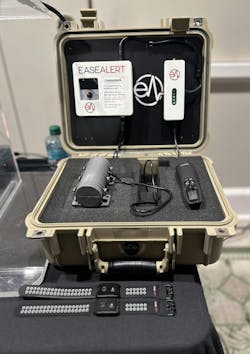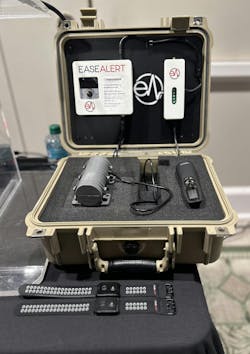FireFusion 2025: Station Alerting and Rest Areas Impact Firefighter Health, Sleep
Disussions around FireFusion 2025 focused on technology making operations and emergency response more efficient, but one session dialed in on ensuring firefighters have access to safer, faster and healthier response alerts.
Dr. Joel Billings, assistant professor at Emroy-Riddle Aeronautical University and CEO of EaseAlert, Blake Richardson, focused their session on how firefighters’ bodies react when they are woken up by an emergency call. The impact varies, based on the stage of sleep, time of day, type of call and body type. No matter the factors, there still is a physiological impact, cardiovascular risk, cumulative exposure and fatigue each time a firefighter is called to duty.
"There's quite a bit of impact when you think about the cummulative, overall exposure, throughout one's career. If you think back to the ice bucket challenge, that one exposure is probably okay, but the repetitive times across one's career, that's where we may have questions," said Billings.
Billings presented statistics from the Center for Fire Rescue and EMS Health Research that showed a spiked heart rate in firefighters when waking up to an emergency alarm and separated those findings into three stages: tone onset, peak and departure.
The concern behind the elevated heart rate is that, over time, it provides even more cardiovascular risk, along with lack of mental and physical clarity. If you use an alarm that’s incredibly loud and boisterous, it leads you to wake up in a panic. From the panicked state, you need to get on your gear, hop in the truck and fight a fire within 10 minutes of waking up from that alarm.
Furthermore, Billings showed that if you are awake for 17 hours, it is equal to a 0.05 blood-alcohol content level (BAC) and that if you are up for 17-24 hours, it is the equivalent of a 0.1 BAC level.
"Firefighters don't get enough sleep at home or at the station. In our research, most firefighters had worse sleep not at the work, but at home. That was an unexpected finding," said Billings.
To combat that, Billings worked through statistics that showed gradual tones reduced the heart rate increase median from seven to five beat per minute, and that firefighters overwhelmingly preferred ramp-up tones and perceived less stress and fatigue.
Billings brought in stats from EaseAlert, co-founded by Richardson, and its implementation of tactile alerts versus standard alerting systems, which showed a 169-percent improvement in health impact.
Many points factor into recovery
To tackle the topic of recovery of trying to mitigate these issues from broken sleep and aggressive alarms, Billings and Richardson started at the beginning.
There is a web of sleep broken into several topics:
- Mental health
- Individual behaviors
- Physical health
- Organizational characteristics
- Sleeping environments
- Physical performance
- Cognitive performance
"A lot of these things are bi-directional. Meaning sleep can influence obesity and obesity means things for sleep," said Billings.
Improving the sleeping environment is the simple answer, but what really factors in that environment?
- Noise: Is there insulation from the ceiling to the floor? Do the doors have a solid or hollow core? Is the placement of the living quarters isolated from internal and external noise? Is there some type of white noise?
- Temperature: What is the temperature in the room? Does the mattress cover set provide an ideal bed temperature? Is there ventilation control for air flow?
- Comfort: What is the mattress type? Has it been cleaned or replaced?
- Light: Do you have blackout curtains? Are the lights motion-activated? What color are the lights in the quarters?
- Well-being/privacy: Are the quarters in an open area, a cubicle or an individual room?
“You can do a lot to make some really big impacts. They are attainable. Regardless of your budget, where you are or what time of year it is, you have the ability to make those impactful changes,” said Richardson.
Alerting options
Richardson took the helm to go over different alerting options and noted that there are trade-offs for every type of alerting option.
Does your firehouse have a mechanical alarm or a ramp-up alarm and is the voice automated or human?
Richardson recommended that firehouses implement red lights within sleeping quarters because it gives you better nighttime vision, the color is less disorienting making you feel less groggy, and it dilates pupils less. Also, in terms of sight, is there a display board that firefighters can look at while putting on their turnout gear? That way they can still get information on the emergency call without a chance of missing information when waking up.
Firehouses can also implement daytime and nighttime modes to their alerting systems. Modes that go into place and differ depending on the time of day, along with zone and unit-specific alerting, so there aren’t any unnecessary wake ups and disturbances.
“Every fire department is unique. Every shift is unique," Richardson said. "We know that it’s not a one-size-fits-all. There’s no cookie cutter answer to it."
He then brought up the EaseAlert tactile alarms that are 43 percent less startling than traditional systems.
It is a device that can be attached to the bed that vibrates to create less startling wake-up that vibrates for 10 seconds with an audible option. There are also devices that can be attached to your watch, or connected to your phone.
Richardson brought up a story of a hearing-impaired Central Florida firefighter that wouldn’t sleep on shift because of the risk of missing the alarms. With EaseAlert’s bunk alert device, that gap is bridged, allowing for those firefighters to be able to get the necessary rest on shift.
Budget concerns
The new technology and different alerting options can provide firefighters with better health, reactivity and operations, but technology costs money. Richardson and Billings gave options for different parameters that fire stations might be working with in terms of money on a per station basis.
Less than $10,000:
- Daytime/nighttime modes: Manual switch for turning bells on and off
- Relay-activated red lights: Improve nighttime alerts
- Separate sleeping areas: Improves comfort and sleep efficiency
$10,000-$50,0000:
- Ramp-up/tactile alerts: Reduces physiological impact and clarity
- Zone/unit-specific alerting: Minimizes unnecessary disruptions
- Display boards and mobile apps: Improves size-ups
More than $50,000:
- Individual bunk rooms: Maximum comfort
- IP-zoned speakers: Only open speakers in rooms for assigned units
- Dorm remote controllers: Dynamic unit assignment on a daily basis
- Other enhancements: Dispatching consoles, doorbell systems and station automations
Some stations may look at these options but have no money. Billings and Richardson made sure to inform the audience about funding sources that include grant opportunities from the Federal Emergency Management Agency, Firehouse Subs Public Safety Foundation, the Leary Firefighters Foundation and the Gary Sinise Foundation. There is the potential for local options that can be researched by a simple google search.
About the Author

Ryan Baker
Ryan Baker is a writer and associate editor with prior experiences in online and print production. Ryan is an associate editor for Firehouse with a master's degree in sciences of communication from the University of Wisconsin-Whitewater. He recently completed a year of teaching Intro to Public Speaking at UW-Whitewater, as part of his graduate program. Ryan acquired his bachelor's degree in journalism in 2023 from UW-Whitewater, and operates currently out of Minneapolis, MN. Baker, also writes freelances for the Ultimate Frisbee Association (UFA) in his free time, while also umpiring baseball for various ages across the Twin Cities Metro Area.

